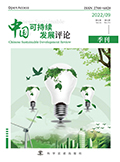

文章基于2010—2022年中国30个省份 (不含西藏和港澳台) 的面板数据, 运用空间固定效应模型、中介效应模型及空间计量模型等方法检验发展新型农业经营主体对农业碳排放强度的影响效应。结果显示: 新型农业经营主体显著降低了农业碳排放强度, 而不同的新型农业经营主体模式对农业碳排放强度的影响途径存在一定差异, 具体体现为农业龙头企业与农民专业合作社通过规模效应、技术进步效应、产业结构优化效应等途径显著降低了农业碳排放强度, 而家庭农场对农业碳排放强度的影响主要体现在技术进步效应方面。进一步分析发现, 某一地区的农业碳排放强度对邻近区域的农业碳排放强度具有正向影响, 不同类型新型农业经营主体对农业碳排放强度的影响在粮食主产区与非粮食主产区具有不同的影响效果。鉴于此本文从培育新型农业经营主体环境效应的视角为降低农业碳排放强度提出相应政策建议。
Based on the panel data of 30 provinces in China (excluding Xizang, Hong Kong, Macao, and Taiwan) from 2010 to 2022, this article employs spatial fixed-effects models, mediation effect models, spatial econometric models, and other methodologies to examine the impact of the development of new agricultural business entities on agricultural carbon emission intensity. The results indicate that new agricultural business entities significantly reduce agricultural carbon emission intensity. However, there exist notable differences in the mechanisms through which different types of new agricultural business entities influence agricultural carbon emission intensity. Specifically, leading agricultural enterprises and farmer cooperatives notably decrease agricultural carbon emission intensity through pathways such as scale effects, technological progress effects, and industrial structure optimization effects. In contrast, the influence of family farms on agricultural carbon emission intensity is primarily manifested in technological progress effects. Further analysis uncovers that the agricultural carbon emission intensity in a given region exerts a positive spillover effect on that of its neighboring regions. Additionally, the impact of diverse types of new agricultural business entities on agricultural carbon emission intensity differs significantly between major grain-producing regions and non-grain-producing regions. Consequently, this study offers pertinent policy suggestions for mitigating agricultural carbon emission intensity, grounded in the environmental implications of fostering new agricultural business entities.